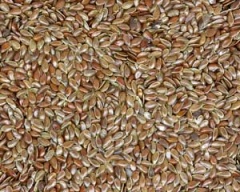Linseed
| Infobox on Linseed | |
|---|---|
| Example of Linseed |  |
| Facts | |
| Origin | - |
| Stowage factor (in m3/t) |
|
| Humidity / moisture |
|
| Ventilation | See text |
| Risk factors | See text |
Linseed
Contents
Description / Application
Flax (also known as common flax or linseed) is a member of the genus Linum in the family Linaceae. It is a food and fibre crop that is grown in cooler regions of the world. Flax fibres are taken from the stem of the plant and are two to three times as strong as those of cotton. As well, flax fibers are naturally smooth and straight. Europe and North America depended on flax for cloth until the nineteenth century, when cotton overtook flax as the most common plant used for making linen paper. Flax is grown on the Canadian Prairies for linseed oil, which is used as a drying oil in paints and varnish and in products such as linoleum and printing inks. It is native to the region extending from the eastern Mediterranean to India and was probably first domesticated in the Fertile Crescent. Flax was extensively cultivated in ancient Ethiopia and ancient Egypt.
Flax is grown for its use as an edible oil, as a nutritional supplement, and as an ingredient in many wood finishing products. Flax is also grown as an ornamental plant in gardens. Flax fibers are used to make linen. The Latin species name usitatissimum means most useful, pointing to the several traditional uses of the plant and their importance for human life.
Flax seeds come in two basic varieties: (1) brown; and (2) yellow or golden. Most types have similar nutritional characteristics and equal numbers of short-chain omega-3 fatty acids. The exception is a type of yellow flax called solin (trade name Linola), which has a (completely) different oil profile and is very low in omega-3 FAs. Although brown flax can be consumed as readily as yellow, and has been for thousands of years, it is better known as an ingredient in paints, fiber and cattle feed. Flax seeds produce a vegetable oil known as flaxseed or linseed oil, which is one of the oldest commercial oils, and solvent-processed flax seed oil has been used for centuries as a drying oil in painting and varnishing.
Flax seed sprouts are edible, with a slightly spicy flavour. Excessive consumption of flax seeds with inadequate water can cause bowel obstruction. Flaxseed, called ('Tisi' or 'Alsi') in northern India, has been roasted, powdered and eaten with boiled rice, a little water, and a little salt since ancient times in the villages.
Whole flax seeds are chemically stable, but ground flaxseed can go rancid at room temperature in as little as one week. Refrigeration and storage in sealed containers will keep ground flax from becoming rancid for a longer period; under conditions similar to those found in commercial bakeries, trained sensory panelists could not detect differences between bread made with freshly ground flax and bread made with milled flax stored for four months at room temperature. Milled flax is remarkably stable to oxidation when stored for nine months at room temperature if packed immediately without exposure to air and light and for 20 months at ambient temperatures under warehouse conditions.
See also Oil Seeds











